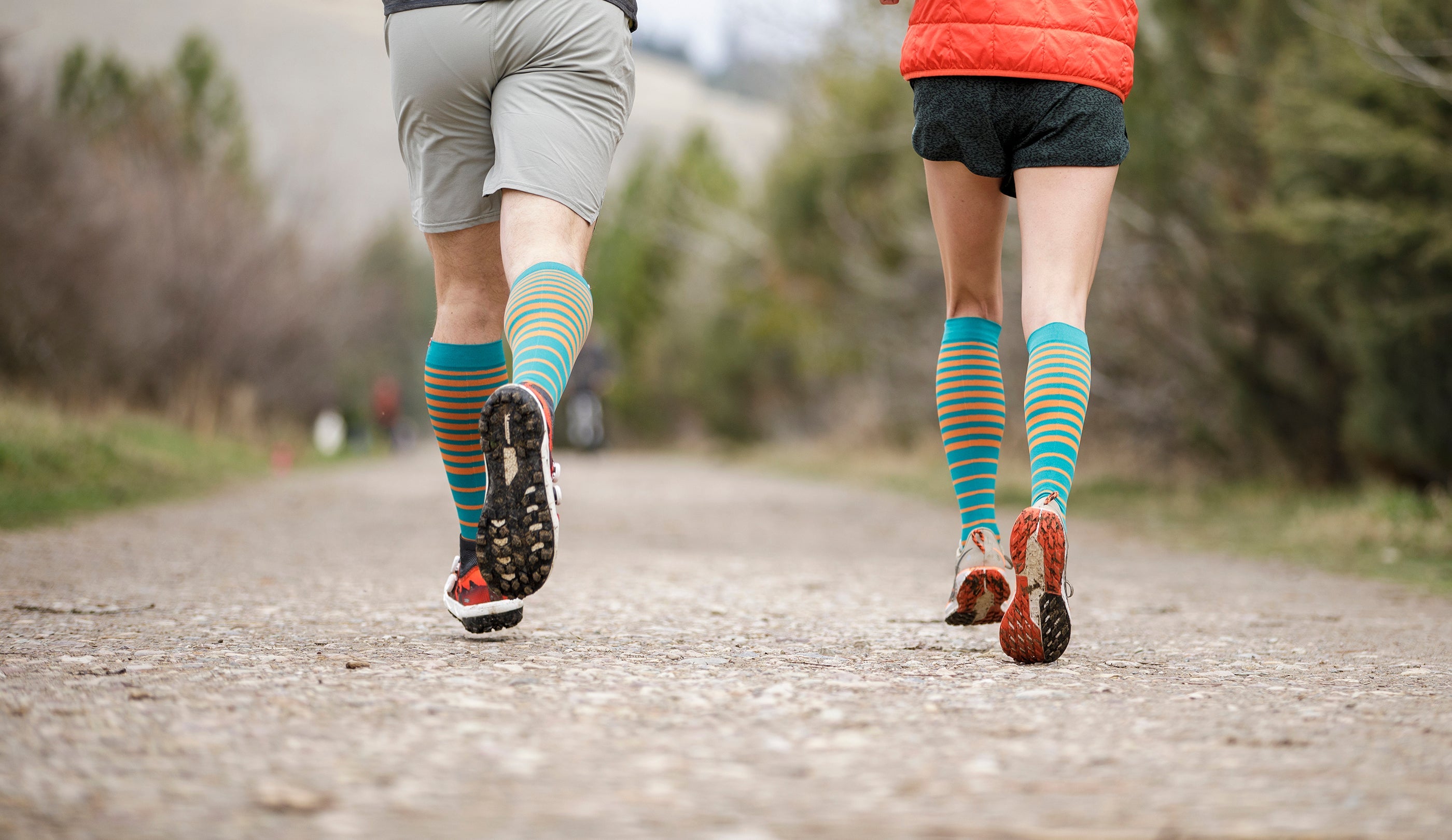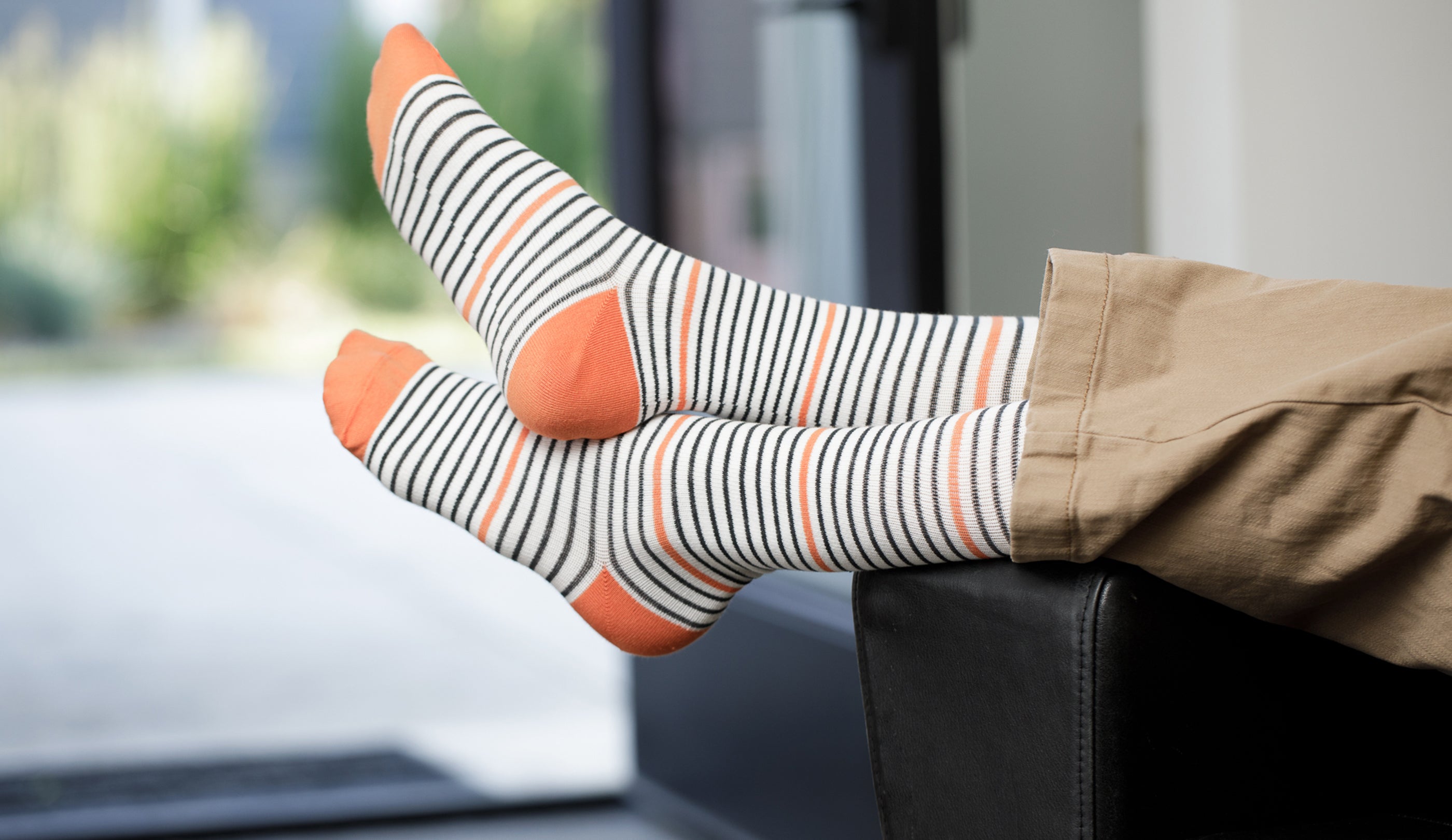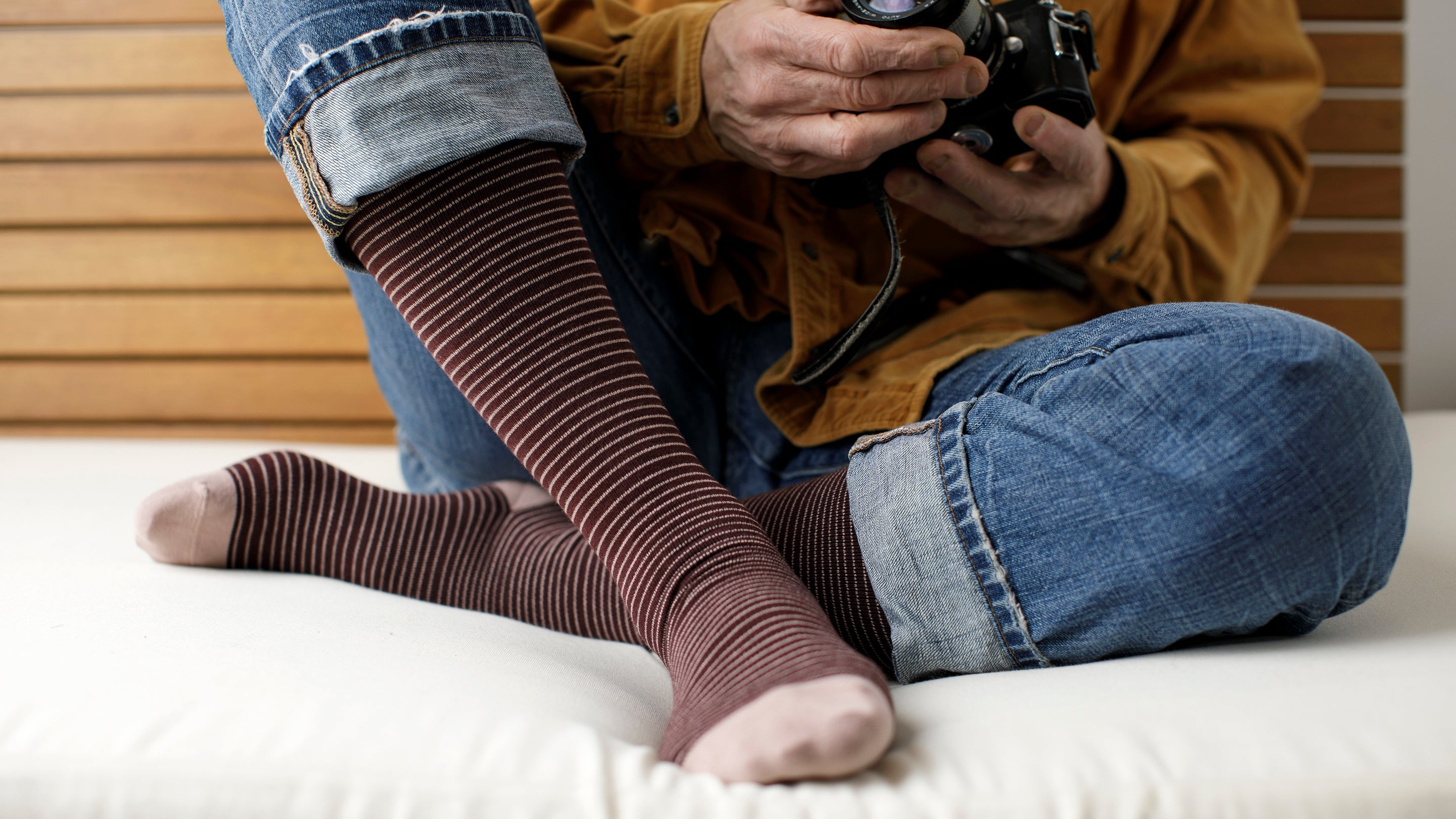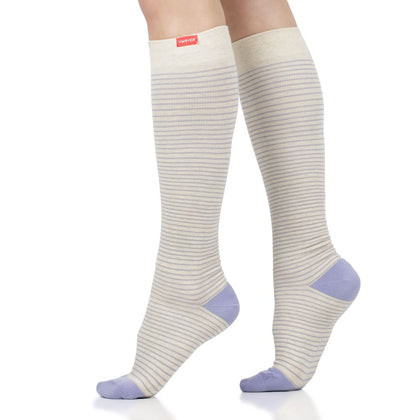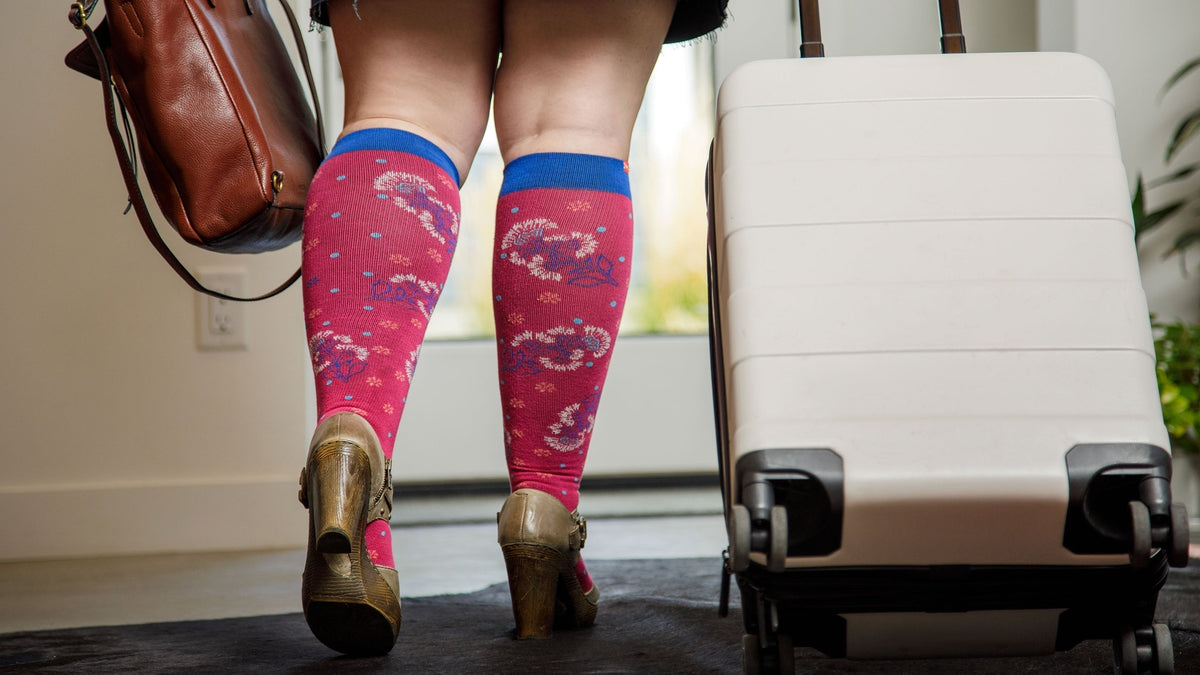

When you travel long distances, sit around in an airplane for hours, or wait in airports for your connecting flights, you have probably wondered, “Why do my feet swell when I travel?”
Feet swelling while traveling is a common issue for both men and women all over the world. Inactivity due to sitting for long periods of time on the plane, awkward positioning in airplane seats where we can’t really move the legs to get blood pumping, or standing around waiting for planes, buses and so on… all these scenarios when you travel can lead to swollen feet and ankles and discomfort.
So, why do feet swell when you travel and how can you avoid or reduce the effects of this swelling? By wearing compression socks, practicing some stretches and healthy habits, you can reduce the swelling of your feet and legs when traveling to help you enjoy the journey a little more.
Here is key information and statistics about foot swelling when traveling:
- According to the CDC, anyone traveling for 4 or more hours is at risk of developing blood clots
- Foot and leg swelling when flying for more than 7 hours occurs in 97% of travelers
- When flying, the risk of deep vein thrombosis increases by 3.2 times
- The risk of thromboembolism, which can be life threatening, increases every 2 hours when traveling
- Wearing graduated compression socks or stockings decreases the risk of deep vein thrombosis by 90%
Read on to find out why your feet swell when you travel, how it is normal for them to be swollen after flights and even after walking, and how to prevent feet swelling while traveling.
Why Do My Feet Get Swollen When I Travel?
Long travel times is known to cause swelling in the feet and legs and may be cause for medical concern, especially for individuals with problems with their blood vessels. In fact, the CDC warns about the possibility of developing blood clots or Deep Vein Thrombosis (DVT) for those who travel on any mode of transportation for longer than four hours at a time.
When you sit still for a long period of time without pumping your leg muscles, blood clots can form in the deep veins on your legs. For most, blood clots do not occur. However, sitting completely immobile on flights increases your risk of blood clots or DVT. The same is true for longer periods of inactivity – say, for example, a long-haul road trip or train ride.
So, why does this happen? Really, it is quite simple. As we move normally during our day, blood is pumped throughout the body. When we are sitting or standing for long periods of time without moving, blood begins to pool in certain areas, mainly the legs. When blood pools, certain things in the blood known as clotting factors begin to stick together. This is one of the key causes of painful leg swelling, edema, and, if blood clotting becomes severe, DVT.
Blood clots can happen to anyone, and traveling is one area where you are at risk, especially if you have had a blood clot before. Dr. Nigel Key from the University of North Carolina stated, “Once you’ve had a blood clot, you’re at high risk of another one.”
What Causes Swollen Feet and Ankles When You Fly?
It is extremely common for feet and ankles to swell when we fly, especially if it is for longer than 4 hours. Commercial airlines – especially when flying in coach – do not allow much space for passengers to stretch their legs or move around during a flight. Moreover, it is quite awkward to walk up and down the aisle of a plane mid flight! As a result, many of us spend hours on end sitting in our seats, not moving our legs and feet.
As we have explained above, this inactivity leads to blood pooling around the lower extremities of your body, which can lead to painful leg and feet swelling as well as edema. Additionally, swelling is caused by retention of other fluids, too. According to this clinical report, when flying, many factors lead to feet swelling like:
- Low air pressure - may increase the activity of clotting factors by two to eightfold
- Prolonged compression of the leg veins - can prevent blood flow out of the legs
- Lack of muscle pumping due to inactivity - muscle movement helps push fluid out from the legs
Is It Normal for Your Feet to Swell on a Long Road Trip?
When the CDC emitted their warning of 4-hour long travel times causing edema and DVT, they specifically stated that planes are not the only mode of transportation that cause feet and ankle swelling. As we have seen, the reason your feet swell on a plane is inactivity, made worse by low air pressure and prolonged vein compression.
The same lack of movement can have a negative effect on your legs and feet if you are traveling in a car or on a train. Luckily, long road trips naturally need to be interrupted by comfort breaks. But, even in those cases, many of us do not move much when we take our breaks. And, let us face it, just like on the plane, cars and trains do not give you all that much room to stretch, either!
As a result, you’ll get swollen ankles and feet from the blood pooling at your extremities during long road trips.
Why Your Feet Swell After Walking
While it may make sense to have your feet swelling while traveling and not moving around a lot, there is also a real risk of swollen lower limbs when you do spend time on your feet. Walking around or standing up for prolonged periods of time causes swelling too. Although you are active and your legs are not confined in a small space, the gravitational pull on your blood makes it harder for blood to be pumped out of the lower leg and feet, which causes foot swelling.
When you walk for a few hours, it is good to stretch and shake out your legs a little bit when you take a break so you can avoid swelling. Moreover, if you are spending a whole day outside and the temperatures change or go through humid spells, this will also influence your feet swelling.
Finally, your diet can affect your feet swelling, too! Salt intake is known to increase fluid retention, which could cause painful swelling of the feet and legs. Notoriously, airplane food has a lot of sodium added to it, which may increase the chances of your feet and ankles swelling.
How to Prevent and Reduce Feet Swelling While Traveling
While you will not be able to increase your seating space when traveling, you can use a few tips and tricks to prevent foot swelling or to reduce the effect of the swelling once it happens.
Wear Compression Socks
One of the best ways to prevent feet swelling during travel is by wearing compression socks, leg sleeves, or tights. A key article from the Mayo Clinic states that you should use “compression stockings to prevent fluid retention.” Through applying gentle pressure to your lower limbs, compression socks, stockings, and leggings promote healthy blood flow and prevent fluids from pooling around your ankles and feet.
Many clinical studies have shown that compression socks are effective for:
- Reducing leg and feet swelling
- Preventing edema
- Reducing your risk of deep vein thrombosis when traveling
Moreover, there are lots of options of compression socks for hikers, walkers and people who spend lots of time on their feet. Merino wool socks are ideal for regulating the temperature and keeping your feet dry and comfortable in almost any condition, especially when traveling.
Watch Your Diet
As we have mentioned, airplane food is full of added sodium, as is most snack food readily available in convenience stores and take-away places. When you are traveling, it can be hard to find healthy food, so you will need to make more of an effort to do so. The same goes for being at all-day events and conferences or working on your feet all day (like nurses) and not having the time to take many breaks to look for healthy options.
So, do your best to limit your salt intake. It is also a good idea to bring some healthy home-made snacks or reach for fruits and vegetables as much as possible.
Stay Hydrated
To make sure that you do not get dehydrated (which can damage your blood vessels and increase inflammation to cause swelling), drink water regularly throughout your journey. According to the Mayo Clinic, to help prevent dehydration that could lead to leg and feet swelling, be sure to drink:
- ~15.5 cups (3.7 liters) of fluid per day if you are a man.
- ~11.5 cups (2.7 liters) of fluid per day if you are a woman.
Move Your Body
Finally, movement is key to combating swollen feet and legs. You may not have a lot of space at your disposal when traveling, but here are some easier ways to add some movement into your lower limbs regardless:
- Massage your feet and calves. This helps increase blood circulation and can be very pleasant – find out how to do it here.
- Elevate your feet if you can. Even just placing them on your carry-on bag for a few minutes can help a lot. Removing your shoes is also a good idea for sleeping on the plane.
- Rotate and flex ankles and knees. This does not require much space. Draw small circles clockwise, then counterclockwise with your feet. Point your toes, then flex your ankles with your toes coming up towards your face. Move your toes around, waving each toe. When you get up, try to do a few short squats (or half-squats) to get your knees flexing a bit. All these movements will push blood back into your limbs and reduce the swelling.
- We also have a collection of long-haul flight exercises you can try here.
All these tips also work for long days spent standing around. And, if you are walking a lot, stretch well once you stop, too.
Should You Be Concerned About Feet Swelling While Traveling?
Most of us will experience a form of feet swelling while traveling, and there is no need to be concerned about it. Swelling caused by too much sodium and/or dehydration also tends to resolve in 1-2 days and with a good diet.
The main reason to be concerned about the swelling is if it tends to go on for too long or if you have had a blood clot in the past. Excessive swelling, persisting for several hours after you start moving again, could point to some underlying condition and should be investigated.
When to Call Your Doctor
You should speak to a doctor if your foot swelling is not showing signs of going down even after you have stretched, moved around, and several hours have passed after your inactivity. More importantly, if only one of your legs is swollen or if you start to feel pain, you should see a medical professional right away.
Finally, if you know you are prone to blood clots, you should check in with your doctor before you plan any air travel. They will advise if it is safe to travel after, for example, a recent major surgery. They could prescribe some blood thinning medication to prevent blood clots and may also advise that you wear compression socks during the flight.
References
Mittermayr, M., Fries, D., Innerhofer, P., Schobersberger, B., Klingler, A., Partsch, H., Fischbach, U., Gunga, H. C., Koralewski, E., Kirsch, K., & Schobersberger, W. (2003). Formation of edema and fluid shifts during a long-haul flight. Journal of travel medicine, 10(6), 334–339. Read it here.
Center for Disease Control and Prevention. (2024). Understanding your risk for blood clots with travel. CDC.gov. Read it here.
Kuipers, S., Cannegieter, S. C., Middeldorp, S., Robyn, L., Büller, H. R., & Rosendaal, F. R. (2007). The absolute risk of venous thrombosis after air travel: a cohort study of 8,755 employees of international organisations. PLoS medicine, 4(9), e290. Read it here.
Chandra, D., Parisini, E., & Mozaffarian, D. (2009). Meta-analysis: travel and risk for venous thromboembolism. Annals of internal medicine, 151(3), 180–190. Read it here.
Clarke, M. J., Broderick, C., Hopewell, S., Juszczak, E., & Eisinga, A. (2016). Compression stockings for preventing deep vein thrombosis in airline passengers. The Cochrane database of systematic reviews, 9(9), CD004002. Read it here.
Geroulakos G. (2001). The risk of venous thromboembolism from air travel. BMJ (Clinical research ed.), 322(7280), 188. Read it here.
Torborg L. (2017). Mild leg swelling should be evaluated. Mayo Clinic Q and A. Read it here.
Partsch, H., Winiger, J., & Lun, B. (2004). Compression stockings reduce occupational leg swelling. Dermatologic surgery : official publication for American Society for Dermatologic Surgery [et al.], 30(5), 737–743. Read it here.
O'Brien, J. G., Chennubhotla, S. A., & Chennubhotla, R. V. (2005). Treatment of edema. American family physician, 71(11), 2111–2117. Read it here.
Dmitrieva, N. I., & Burg, M. B. (2015). Elevated sodium and dehydration stimulate inflammatory signaling in endothelial cells and promote atherosclerosis. PloS one, 10(6), e0128870. Read it here.
